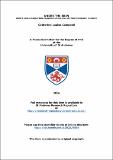Files in this item
Under the skin : Monte Carlo radiation transfer modelling of photodynamic therapy
Item metadata
| dc.contributor.advisor | Wood, Kenny | |
| dc.contributor.advisor | Brown, C. Tom A. | |
| dc.contributor.advisor | Moseley, Harry | |
| dc.contributor.author | Campbell, Catherine Louise | |
| dc.coverage.spatial | xxix, 221, [18] p. | en_US |
| dc.date.accessioned | 2016-11-29T11:00:49Z | |
| dc.date.available | 2016-11-29T11:00:49Z | |
| dc.date.issued | 2016 | |
| dc.identifier.uri | https://hdl.handle.net/10023/9899 | |
| dc.description.abstract | Photodynamic therapy (PDT) is a non-invasive treatment method used for treating superficial skin lesions such as non-melanoma skin cancer (NMSC). The combination of light, a photo- sensitive molecule and oxygen results in selective tissue destruction. Even though PDT has resulted in many successful treatment outcomes, the treatment parameters such as required light dose and preferred light source have not yet been optimised. Since monitoring of the treatment progress is limited to surface observations, it is difficult to observe what is happening under the surface of the skin. In this thesis, the development of complex numerical modelling techniques is considered with the aim of increasing the understanding of how PDT works within the living skin tis- sue. In particular, the potential of using daylight as an alternative therapeutic light source is explored. Daylight PDT is associated with lower experienced pain and has the potential of reducing pressure on the clinics as well as the number of treatment occasions. A Monte Carlo radiation transfer (MCRT) model was developed to track photon propagation during treatment. The first theoretical investigation of daylight PDT is presented where the results indicate a potential treatment depth of over 2 mm, which is sufficient for treating superficial skin cancer lesions. Additional models are developed, which consider the drug interaction and the diffusion of the drug. To include different patient characteristics and more detailed skin models, multi-layered tissue as well as complex three dimensional tumour tissues are included within the MCRT model framework. There is no such thing as a generic patient, making it difficult to generate standardised treatment protocols. The research performed in this thesis provides further insights into light interaction with skin tissue for different patient and treatment characteristics, which is a vital step towards achieving more individualised treatment regimes. | en_US |
| dc.language.iso | en | en_US |
| dc.publisher | University of St Andrews | |
| dc.subject.lcc | RC271.P43C2 | |
| dc.subject.lcsh | Photochemotherapy | |
| dc.subject.lcsh | Monte Carlo method | |
| dc.title | Under the skin : Monte Carlo radiation transfer modelling of photodynamic therapy | en_US |
| dc.type | Thesis | en_US |
| dc.type.qualificationlevel | Doctoral | en_US |
| dc.type.qualificationname | PhD Doctor of Philosophy | en_US |
| dc.publisher.institution | The University of St Andrews | en_US |
This item appears in the following Collection(s)
Items in the St Andrews Research Repository are protected by copyright, with all rights reserved, unless otherwise indicated.

